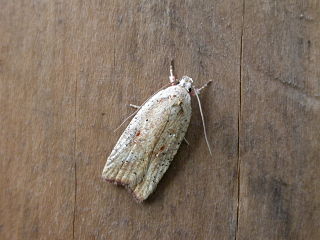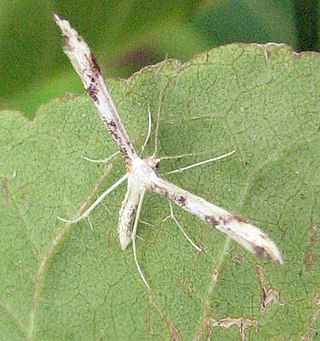
Hypericum is a genus of flowering plants in the family Hypericaceae. The genus has a nearly worldwide distribution, missing only from tropical lowlands, deserts and polar regions. Many Hypericum species are regarded as invasive species and noxious weeds. All members of the genus may be referred to as St. John's wort, and some are known as goatweed. The white or pink flowered marsh St. John's worts of North America and eastern Asia are generally accepted as belonging to the separate genus TriadenumRaf.

The setaceous Hebrew character is a moth of the family Noctuidae. The species was first described by Carl Linnaeus in his 1758 10th edition of Systema Naturae. It is found in the Palearctic realm. It is a common species throughout Europe and North Asia and Central Asia, South Asia, China, Japan and Korea. It is also found in North America, from coast to coast across Canada and the northern United States to western Alaska. It occurs in the Rocky Mountains from Montana to southern Arizona and New Mexico. In the east, it ranges from Maine to North Carolina. It has recently been recorded in Tennessee.

The gorse tip moth is a smallish moth species of the family Depressariidae.

Agrochola litura, the brown-spot pinion, is a moth of the family Noctuidae. The species was first described by Carl Linnaeus in 1761. It is found in Europe and the Middle East. It is possibly also present in North Africa, but this is unclear because similar looking species Agrochola meridionalis is found there.

Adaina montanus is a moth of the family Pterophoridae. It is found in North America, including south-eastern Canada and the north-eastern United States.

Oidaematophorus guttatus is a moth of the family Pterophoridae. It is found in the United States.

Agonopterix fruticosella is a moth of the family Depressariidae. It is found in southern France and on the Iberian Peninsula.

Agonopterix perezi is a moth of the family Depressariidae. It is found on the Canary Islands and Madeira.
Agonopterix antennariella is a moth in the family Depressariidae. It was described by John Frederick Gates Clarke in 1941. It is found in Washington, British Columbia and western Greenland.
Agonopterix nubiferella is a moth in the family Depressariidae. It was described by Walsingham in 1881. It is found in North America, where it has been recorded from northern California to British Columbia.
Agonopterix sabulella is a moth in the family Depressariidae. It was described by Walsingham in 1881. It is found in North America, where it has been recorded from Idaho, Alberta and British Columbia and from Washington to Arizona and California.
Agonopterix trimenella is a moth in the family Depressariidae. It was described by Walsingham in 1881. It is found in South Africa.
Agonopterix sanguinella is a moth in the family Depressariidae. It was described by August Busck in 1902. It is found in North America, where it has been recorded from Arizona, New Mexico and Nevada.
Agonopterix walsinghamella, or Walsingham's agonopterix moth, is a moth in the family Depressariidae. It was described by August Busck in 1902. It is found in North America, where it has been recorded from the north-eastern United States and Canada.
Agonopterix pavida is a moth in the family Depressariidae. It was described by Edward Meyrick in 1913. It is found in Asia Minor.
Agonopterix remota is a moth in the family Depressariidae. It was described by Edward Meyrick in 1921. It is found in Palestine.
Depressaria alienella is a moth in the family Depressariidae. It was described by August Busck in 1904. It is found in North America, where it has been recorded from Yukon to Nova Scotia, south to New England, Arizona and California.
Agonopterix rubristricta is a moth in the family Depressariidae. It was described by Walsingham in 1912. It is found in Guatemala.
Chionodes creberrima is a moth in the family Gelechiidae. It is found in Mexico (Guerrero).
Hypericum umbraculoides is a species of flowering plant, a deciduous shrub in the St. John's wort family, Hypericaceae. It is the sole species in the section Hypericum sect. Umbraculoides.







